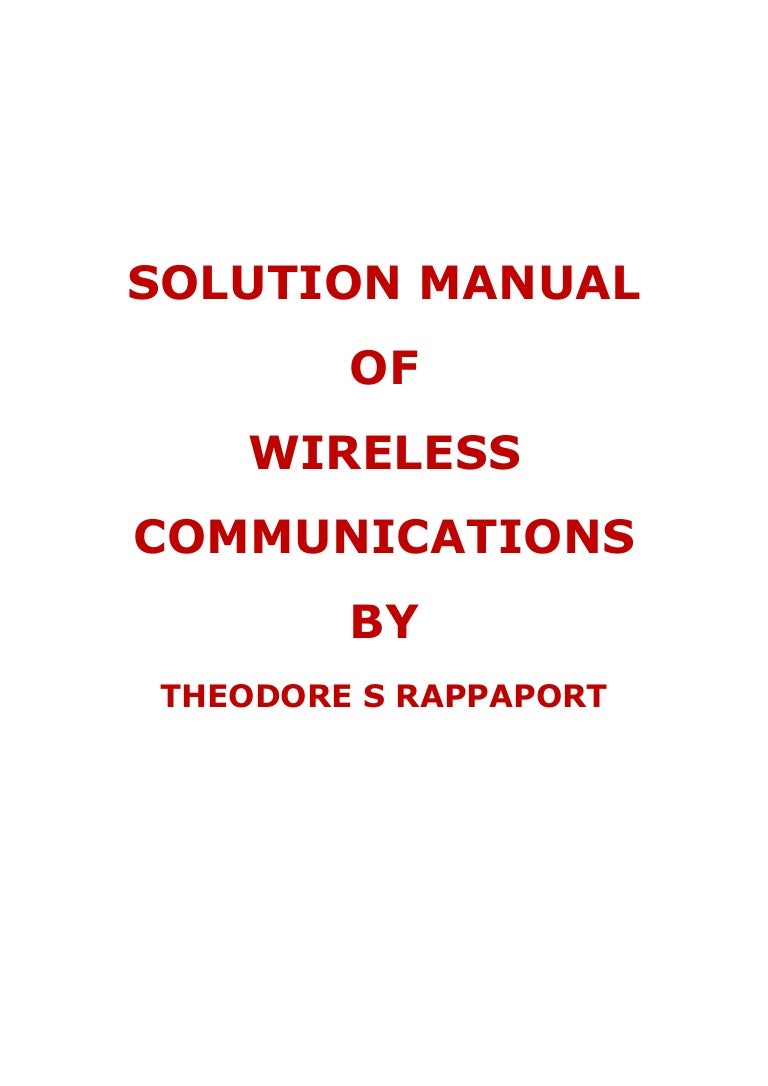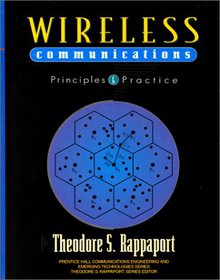Theodore S Rappaport Wireless Communications Pdf
Description
Wideband Millimeter-Wave Propagation Measurements and Channel Models for Future Wireless Communication System Design TS Rappaport, G MacCartney, M Samimi, S Sun IEEE Transactions on Communications 63 (9), 3029-3056, 2015. BMW Z4'pdf wireless communication theodore s rappaport april 27th, 2018 - wireless communications is limited by the propagation pdf plasma raman scattering char theodore ted rappaport a pioneering researcher in millimeter wave 'WIRELESS COMMUNICATIONS By Rappaport T S Study Material. PDF wireless communication Find, read and cite all the research you need on ResearchGate Book PDF Available Wireless Communications by Theodore S. Rappaport (z-lib.org).
For cellular radio engineers and technicians.
The leading book on wireless communications offers a wealth of practical information on the implementation realities of wireless communications. This book also contains up-to-date information on the major wireless communications standards from around the world. Covers every fundamental aspect of wireless communications, from cellular system design to networking, plus world-wide standards, including ETACS, GSM, and PDC. Theodore Rappaport is Series Editor for the Prentice Hall Communication, Engineering, and Emerging Technologies Series.
Features
- Complete information on all of the world's most important standards-For cellular, cordless telephone, and personal communications systems, including AMPS, ETACS, U.S. Digital Cellular, GSM, CDMA, DECT, WACS, CT-2, PDC, and CDPD.
Learn the latest in wireless communications standards that are a part of the future of communication, including the new 3G interface standards. Ex.___
- All new end of chapter solved example problems-On topics ranging from cellular system design to networking.
Added re-inforcement through practical problem sets. Ex.___
- Hundreds of figures, tables, and diagrams-With clear explanations of all major concepts.
Students learn through clear, illustrated representation of wireless concepts. Ex.___
Table of Contents
Preface.
1. Introduction to Wireless Communication Systems.
2. Modern Wireless Communication Systems.
Second Generation (2G) Cellular Networks. Third Generation (3G) Wireless Networks. Wireless Local Loop (WLL) and LMDS. Wireless Local Area Networks (WLANs). Bluetooth and Personal Area Networks (PANs). Summary. Problems.
3. The Cellular ConceptÑSystem Design Fundamentals.
Introduction. Frequency Reuse. Channel Assignment Strategies. Handoff Strategies. Interference and System Capacity. Trunking and Grade of Service. Improving Coverage & Capacity in Cellular Systems. Summary. Problems.
4. Mobile Radio Propagation: Large-Scale Path Loss.
Introduction to Radio Wave Propagation. Free Space Propagation Model. Relating Power to Electric Field. The Three Basic Propagation Mechanisms. Reflection. Ground Reflection (Two-Ray) Model. Diffraction. Scattering. Practical Link Budget Design Using Path Loss Models. Outdoor Propagation Models. Indoor Propagation Models. Signal Penetration into Buildings. Ray Tracing and Site Specific Modeling. Problems.
5. Mobile Radio Propagation: Small-Scale Fading and Multipath.
Small-Scale Multipath Propagation. Impulse Response Model of a Multipath Channel. Small-Scale Multipath Measurements. Parameters of Mobile Multipath Channels. Types of Small-Scale Fading. Rayleigh and Ricean Distributions. Statistical Models for Multipath Fading Channels. Theory of Multipath Shape Factors for Small-Scale Fading Wireless Channels. Summary. Problems.

6. Modulation Techniques for Mobile Radio.


Frequency Modulation vs. Amplitude Modulation. Amplitude Modulation. Angle Modulation. Digital Modulation: An Overview. Line Coding. Pulse Shaping Techniques. Geometric Representation of Modulation Signals. Linear Modulation Techniques. Constant Envelope Modulation. Combined Linear and Constant Envelope Modulation Techniques. Spread Spectrum Modulation Techniques. Modulation Performance in Fading and Multipath Channels. Problems.
7. Equalization, Diversity, and Channel Coding.
Introduction. Fundamentals of Equalization. Training A Generic Adaptive Equalizer. Equalizers in a Communications Receiver. Survey of Equalization Techniques. Linear Equalizers. Nonlinear Equalization. Algorithms for Adaptive Equalization. Fractionally Spaced Equalizers. Diversity Techniques. RAKE Receiver. Interleaving. Fundamentals of Channel Coding. Block Codes and Finite Fields. Convolutional Codes. Coding Gain. Trellis Coded Modulation. Turbo Codes. Problems.
8. Speech Coding.
Introduction. Characteristics of Speech Signals. Quantization Techniques. Adaptive Differential Pulse Code Modulation (ADPCM). Frequency Domain Coding of Speech. Vocoders. Linear Predictive Coders. Choosing Speech Codecs for Mobile Communications. The GSM Codec. The USDC Codec. Performance Evaluation of Speech Coders. Problems.
9. Multiple Access Techniques for Wireless Communications.
Introduction. Frequency Division Multiple Access (FDMA). Time Division Multiple Access (TDMA). Spread Spectrum Multiple Access. Space Division Multiple Access (SDMA). Packet Radio. Capacity of Cellular Systems. Problems.
10. Wireless Networking.
Introduction to Wireless Networks. Differences Between Wireless and Fixed Telephone Networks. Development of Wireless Networks. Fixed Network Transmission Hierarchy. Traffic Routing in Wireless Networks. Wireless Data Services. Common Channel Signaling (CCS). Integrated Services Digital Network (ISDN). Signaling System No. 7 (SS7). An Example of SS7 Ñ Global Cellular Network Interoperability. Personal Communication Services/Networks (PCS/PCNs). Protocols for Network Access. Network Databases. Universal Mobile Telecommunication System (UMTS). Summary.
What Is Wireless Communications
11. Wireless Systems and Standards.AMPS and ETACS. United States Digital Cellular (IS-54 and IS-136). Global System for Mobile (GSM). CDMA Digital Cellular Standard (IS-95). CT2 Standard for Cordless Telephones. Digital European Cordless Telephone (DECT). PACS Ñ Personal Access Communication Systems. Pacific Digital Cellular (PDC). Personal Handyphone System (PHS). US PCS and ISM Bands. US Wireless Cable Television. Summary of Standards Throughout the World. Problems.
Appendix A. Trunking Theory.
Erlang B. Erlang C.
Appendix B. Noise Figure Calculations for Link Budgets.
Appendix C. Rate Variance Relationships for Shape Factor Theory.
 Rate Variance for Complex Voltage. Rate Variance for Power. Rate Variance for Envelope.
Rate Variance for Complex Voltage. Rate Variance for Power. Rate Variance for Envelope.Theodore S Rappaport Wireless Communications Pdf Download
Appendix D. Approximate Spatial Autocovariance Function for Shape Factor Theory.Appendix E. Gaussian Approximations for Spread Spectrum CDMA.
The Gaussian Approximation. The Improved Gaussian Approximation (IGA). A Simplified Expression for the Improved Gaussian Approximation (SEIGA).

Appendix F. Q, erf & erfc Functions.
The Q-Function. The erf and erfc Functions.
Appendix G. Mathematical Tables, Functions, and Transforms.
Appendix H. Abbreviations and Acronyms.
Appendix I. References.
Index.
Back Cover
The indispensable guide to wireless communications-now fully revised and updated!
Wireless Communications: Principles and Practice, Second Edition is the definitive modern text for wireless communications technology and system design. Building on his classic first edition, Theodore S. Rappaport covers the fundamental issues impacting all wireless networks and reviews virtually every important new wireless standard and technological development, offering especially comprehensive coverage of the 3G systems and wireless local area networks (WLANs) that will transform communications in the coming years. Rappaport illustrates each key concept with practical examples, thoroughly explained and solved step by step. Coverage includes:
- An overview of key wireless technologies: voice, data, cordless, paging, fixed and mobile broadband wireless systems, and beyond
- Wireless system design fundamentals: channel assignment, handoffs, trunking efficiency, interference, frequency reuse, capacity planning, large-scale fading, and more
- Path loss, small-scale fading, multipath, reflection, diffraction, scattering, shadowing, spatial-temporal channel modeling, and microcell/indoor propagation
- Modulation, equalization, diversity, channel coding, and speech coding
- New wireless LAN technologies: IEEE 802.11a/b, HIPERLAN, BRAN, and other alternatives
- New 3G air interface standards, including W-CDMA, cdma2000, GPRS, UMTS, and EDGE
- Bluetooth wearable computers, fixed wireless and Local Multipoint Distribution Service (LMDS), and other advanced technologies
- Updated glossary of abbreviations and acronyms, and a thorough list of references
- Dozens of new examples and end-of-chapter problems
Whether you're a communications/network professional, manager, researcher, or student, Wireless Communications: Principles and Practice, Second Edition gives you an in-depth understanding of the state of the art in wireless technology-today's and tomorrow's.
Author
THEODORE S. RAPPAPORT is a professor of Electrical and Computer Engineering at the University of Texas, and director of the Wireless Networking and Communications Group (WNCG.org). In 1990, he founded the Mobile and Portable Radio Research Group (MPRG) at Virginia Tech, one of the first university research and educational programs for the wireless communications field. He is the editor or co-editor of four other books on the topic of wireless communications, based on his teaching and research activities at MPRG.
